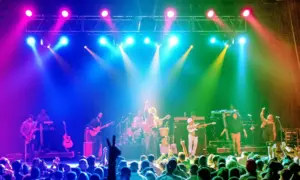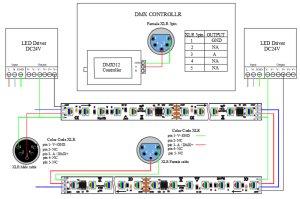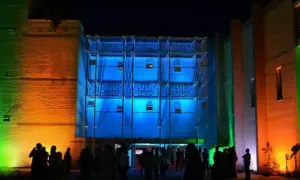Have you ever thought of lights of different colors syncing with concerts and stage shows? Moreover, the light also syncs with music beats in clubs. This happens due to DMX lighting setups. However, many don’t have any idea about DMX. So they ask: What are DMX LED lights and how do they work?
Understanding the workings of DMX LED lights is crucial. It helps choose how to control multiple lights with various colors. Remember, controlling numerous lights at the same time is very challenging. DMX is modern technology that allows us to control light efficiently. In this article, we will discuss DMX-based lights in detail. So, let’s get started!

What Are DMX LED Lights?
Let’s first debunk the details of what DMX is!
DMX is the standard for Digital Multiplex. It is a communication protocol to control the workings of different lights (or lighting setups). It helps control multiple lights by using signals. Its function expands beyond light and can control fog machines, lasers, moving heads, etc.
The DMX LED lights use this DMX (Digital Multiplex) technology. So, these lights are controlled quite easily (remotely). Moreover, you’ll notice them giving off different colors with perfect sync. This happens when this system gives a desired signal to a specific light through channels. So you have a single controller, sitting in one place, and controlling the functionality of all the lights.

The DMX LED light gets a signal from the DMX controller. These signals reach the light fixture through channels. After interpreting a signal, the LED light performs specific actions. Those actions can include:
- Changing colors
- Switch on and off
- Flashing or strobing
- Dimming & Sharpening
- Moving (If the light has a moving head)
The DMX, also called DMX512, can handle 512 channels simultaneously. Remember, a channel is a control line associated with a light’s functionality. For example, a signal from one channel will make the light glow red. Similarly, the second channel will be green. The controller will send specific signals through the appreciative channel as required.
The DMX sounds like newer technology. However, it has been in use since 1986. Before that, the stage show lighting was boring. Changing colors, fading in & out, and synchronizing with music was impossible. However, the introduction of DMX technology has proved to be a significant innovation in the lighting industry.
How Do DMX LED Lights Work?
DMX LED lights have a few key components that play a key role in their operation. Those include DMX controllers, cables, and light fixtures. Each element has a specific role in the operation of DMC lights. In the section below, we will discuss the operation of DMX lights.
1- Controller Sends Signals
The DMX controller is the most critical component of DMX lighting. It sends signals to the lights, and the LED light follows them to show any action. Different types of DMX controllers are available.
Some are smaller and simpler to use, ideal for fewer lights. Conversely, some complex controllers are available and suitable for high-end lighting setups. Generally, large public shows and concert lighting setups use these complex DMX controllers.
2- Signal Travels Through DMX Cables
As I said, the DMX system uses dedicated cables to transmit data. This data goes from the DMX controller to the light fixture. The cables used in this system are called DMX cables and are of the highest quality.
Some DMX cables have three pins, while others have five pins. Modern DMX systems use the 5-pin cables. However, you will still see some old systems using 3-pin cables. Remember, you should always use high-quality DMX cables. Using low-quality cable can result in loss or disruption of signals.
3- DMX Addressing & DMX Channels
DMX addressing is a critical step in the workings of DMX-based lighting. The DMX system assigns a specific address to each light fixture. This address helps the fixture understand which channel the light will listen to. In this way, the light gets the proper signal and works correctly.
Remember, one light fixture can have multiple channels, each with a specific role. For example, you have DMX-based RGB. In this way, there will be three channels: one for red, one for green, and one for blue. This means the red, blue, and green colors will be controlled through dedicated channels.
The DMX addressing helps the light fixture determine which channel to listen to. If the signal comes through channel 2 (green), the fixture will only listen to channel 2, which will cause the light to shine green. The value of each channel can be between 0 and 255. A channel with a 0 value means no light. Similarly, a channel with a 255 value means a fully bright light.
4- Fixtures React to DMX Commands
The DMX light fixture receives the signal through the cables. These lights interpret the signal’s value and then perform specific actions. As I said earlier, channels play a key role in light functionality. After reading the value in each channel, the light turns on and off, and reduces brightness.
You’ll be able to adjust the value using the DMC controller. The light will behave according to the controller’s adjustment. This means you won’t have to control the light or its dynamic effects like strobes or fades. Instead, you can control all the lights by combining channels and varying their values.
Advantages of Using DMX LED Lights
The DMX LED light has been a massive innovation in the lighting industry. Most events, stage shows, concerts, and clubs use DMX-based lights. Let’s discuss the key benefits of these lights:

- Multiple Lights: The DMX system can help control multiple lights from a single unit. So you won’t have to adjust the lighting color, brightness, or the affected individuals. You can connect various DMX lights in series and control them through a controller.
- Precise Control: One key benefit of DMX-based lights is their precision. The controller sends signals and controls the light in real-time. As a result, the DMX LED light gives color fading and other effects with 100% precision. This makes the light ideal for modern concerts and clubs.
- Sync with Music: Have you noticed light dancing with the beat of music? This is very common in clubs and concerts. This is due to the effect of DMX-based lights. They sync perfectly with music and flash, fade, or change colors with beats.
- Scalable System: The DMX lighting setup is highly scalable. You can use as many DMX LED lights as you want. All you’ll have to do is to connect all the lights in the series. The DMX controllers send signals through cable and control the functionality of these lights.
- Cost-Effective in the Long Run: DMX lights are expensive as they use many advanced components. However, they prove to be very cost-effective in the long run. You can use them for many years in stage shows and clubs. The old lights are inexpensive but require more human labor to handle.
Frequently Asked Questions
How many lights can DMX control?
The DMX system can control 512 LED lights at a time. You can connect the lights in series. The DMX controllers will signal all the lights and control their operation.
What is DMX lighting used for?
The DMX lights are used in stage shows, concerts, and clubs. They provide different effects of lights. Those include flash, fade, or change colors and light syncing with music beats.
What is the function of the DMX system?
The primary function of the DMX system is to control the working of many lights with a single unit. It controls how light turns on/off, flashes, fades, and changes color in different events and shows.
Conclusion
Let’s conclude – Is DMX Lighting Right for You? The answer is YES, depending on your use. These lights suit you if you are a club owner or organize a local concert or show. They will provide excellent lighting solutions with different colors and dynamic effects. However, you should also consider their initial cost, which can be a drawback.
